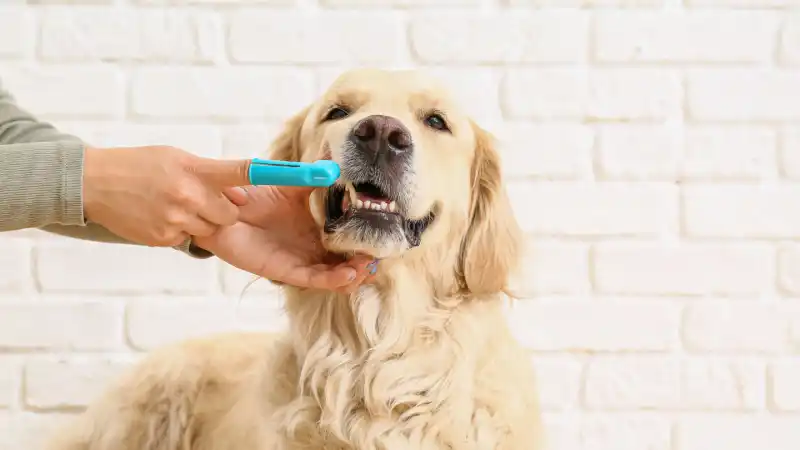Signs & Symptoms of Cancer in Dogs
How do you know if your dog has cancer? We'll help you look for the common signs and symptoms of cancer in dogs, and how your veterinarian can test for it.

In light of National Canine Cancer Awareness month, I wanted to try to answer a question that many dog owners have— “How can I tell if my dog has cancer?” Unfortunately, I cannot write an article about “3 Easy Steps on How to Know if My Dog Has Cancer.” That doesn’t even exist! What I can tell you is how to improve early detection.
What Does Cancer Look Like?
Canine cancer comes in all shapes, sizes, and locations and does not discriminate with regard to age and breed. One in four dogs will develop cancer in their lifetime, making it the number one cause of disease-related death in dogs. Research has shown that early detection is the best method, and one of the only methods in our control, for determining a promising cancer prognosis. Unfortunately, not all cancers are easy to detect.
In an attempt to help dog owners identify cancer in its earliest stages, I’ve broken cancer down into four very broad and non-scientific categories:
External cancer
Internal cancers
Bone cancers
Blood cancers
External Cancer
An external cancer will often be referred to as a “lump”, “mass,” or “tumor”. Tumor is what most people think of when they think of cancer. However, the word “tumor” does not necessarily mean cancer. A tumor is defined as “a swelling of a part of the body, generally without inflammation, caused by an abnormal growth of tissue, whether benign or malignant.” Note that the words benign (non-cancerous) or malignant (cancerous) can apply to the word tumor. In fact, all four of the above terms can be used interchangeably. For example, a mass can be malignant, and a tumor can be benign. Therefore, don’t panic if your veterinarian uses one of these terms over another!
What to Look For:
External masses can come in every shape, size, color, and location. Size isn’t always a good indicator of seriousness. Small masses can have a poor prognosis and larger masses can have a good prognosis. It’s almost impossible to look at a mass and definitively tell whether it is malignant or not.
Whenever you notice a new growth, lump, or bump on your dog, or you notice that one is changing, you should bring it to your veterinarian’s attention. They will be able to examine it and possibly do some simple tests to tell you if it warrants concern.
Luckily, the best way to identify a new mass and monitor an existing mass is by petting, grooming, and bathing your dog! Not too bad, right? Be sure to feel all over their body—their legs, toes, ears, neck, tail, and, if possible, their mouth. It’s good to get in the habit of examining your dog like this on a regular basis so you know if anything is new or changing.
Internal Cancer
This one is a tough one. Obviously, we can’t see inside our dogs, and they can’t tell us how they’re feeling. How do you know what’s going on in there? An internal cancer is a mass or tumor that is inside the body. That could be organs like the liver, spleen, kidneys, heart, stomach, lungs, and so on.
What to Look For:
My best recommendation is to keep up with your dog’s annual wellness exam, especially as your dog ages. They will perform a thorough physical exam and may run annual bloodwork that will check organ function and blood counts. Abnormalities on the lab work could alert you to an underlying issue that needs further workup.
A few things you can monitor at home are your dog’s:
**Food and Water Intake:**Too much? Too little?
**Bathroom Habits:**Do they need to go outside more? Less? Are their bowel movements normal?
**Attitude:**Does your dog seem to be depressed? Are they lying around a lot? Hiding?
**Behavior:**Has your dog lost interest in normal activities? Have there been changes in routine?
**Pain or Discomfort:**Whining? Reacting to your touch as if it’s painful? Limping?
**Vitals:**Breathing heavy? Shallow Breathing? Panting?
Go with your gut. You know your dog the best, so any abnormal or concerning behaviors can warrant a quick trip to the vet.
Blood Cancer
Blood cancers are another challenging one to identify since, again, they are not visible. Most people know leukemia and lymphoma can occur in humans, but do not realize dogs can get leukemia and lymphoma as well. Both leukemia and lymphoma are cancers of the bloodstream and/or lymphatic system.
What to Look For:
The best way to detect these types of cancer is similar to the above. Examine your dog frequently, feeling for swollen lymph nodes which are typically around the neck and the back of the hind legs. Swollen lymph nodes can often feel like a mass when very large. Also, take note of any unusual skin lesions, as bruising can be a sign that certain cells in the bone marrow are low. These cancers can also be detected on lab work. Keeping up with annual vet visits and blood work can help detect these types of cancer. Though most often not outwardly visible, these cancers can make your dog not feel well, so monitor your dog for abnormal behavior or changes in habits.
Bone Cancer
And finally, bone cancer. Bone cancer is more common in large and giant breed dogs than small breed dogs, but it can affect any size of dog. The primary indication of bone cancer is pain or discomfort. Swelling can exist around the location of the cancer, but sometimes swelling is not present at all.
What to Look For:
Bone cancers are often found in the limbs and accompanied by limping. They can also arise in other parts of the body like the ribs, spine, and skull, where they are painful to the touch and/or swollen. Bone cancer is a very painful disease and often progresses quickly, so if your dog (especially if they’re an elderly, large breed dog) suddenly begins limping or showing unexplained signs of pain, it is best to take your dog to the vet to get checked out. An X-ray is typically performed to look for changes in the bone caused by cancer and a sample of this area may be taken for a diagnosis.
In short, I can’t give you a fool-proof way to guarantee your dog won’t get cancer; nor can I tell you about the one test that will tell you if your dog has cancer. We all want our canine companions to be here with us for as long as possible. My hope is that this very basic overview educates dog owners on the different faces of canine cancer and, in turn, increases the chances of early detection.
Cancer coverage is included in AKC Pet Insurance’s base Accident & Illness Plan (underwritten by Independence American Insurance Company). If you would like more information about our customizable plans, click here for a quote or call 1-866-725-2747 and have one of our Customer Care Team members walk you through available coverage options.
The information provided in this blog is intended for educational purposes only and should not serve as a substitute for the professional medical advice of your veterinarian. Always consult your veterinarian with questions about your pet’s health and before initiating any treatment regimes.

Every Dog and Cat Deserves the Pet Insurance of Champions
Get prize-winning care for your pets.

Erin Tursam comes to AKC Pet Insurance with a background in veterinary medicine. As the Marketing Manager at PetPartners, she uses her knowledge and experience to help pet owners better understand the health needs of their pets and how pet insurance can help keep them happy and healthy. Erin lives in Apex, NC and has a 13-year-old Cavalier King Charles Spaniel and 7-year-old Doberman.
READ MORE ARTICLES

